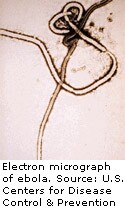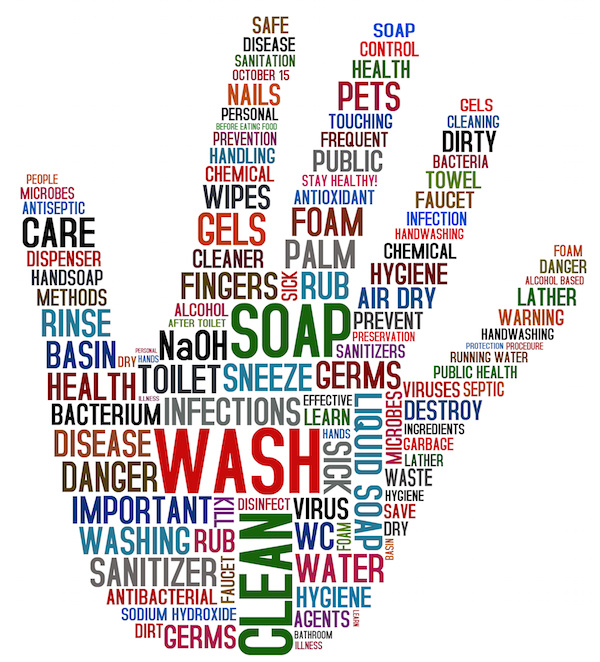
MONDAY, April 14, 2014 (HealthDay News) — As a major outbreak of deadly Ebola virus spreads through the West African nations of Guinea and Liberia, public health officials are struggling to contain the horror-movie pathogen before it slips into neighboring countries.
They must do so without the aid of any vaccines to prevent Ebola’s spread or medicines to treat Ebola infections. None currently exists.
But scientists say they are beginning to close in on ways to stop the virus. Several promising vaccines and medications are under development, although all are still years from availability, said Dr. Anthony Fauci, director of the U.S. National Institute of Allergy and Infectious Diseases (NIAID).
Currently, the best treatment for Ebola involves providing fluid to the patient to replace the bleeding that occurs from all orifices as the hemorrhagic fever destroys the body from within.
“If you have a medical facility to give you blood or plasma or fluid, you’re not specifically attacking the Ebola, but you’re giving the patient a better chance of surviving,” Fauci explained. “Some people who have the best medical care still die, and there are some people with no care who survive. But you have the best chance if you have medical care.”
As of late last week, the number of suspected cases in Guinea had swelled to 158, with 101 deaths, according to the World Health Organization. There are 25 reported cases in nearby Liberia, including 12 deaths.
Most deaths have occurred in the southeastern Guinea city of Guekedou, which lies near the borders of Sierra Leone and Liberia. Suspected cases have been reported in Sierra Leone, Mali and Ghana, but none has been confirmed.
Ebola’s average death rate is about 70 percent, but can range between 20 percent and 90 percent depending on the strain, Fauci said.
The most promising efforts to develop an Ebola vaccine involve genetic splicing, Fauci said. In this line of research, NIAID investigators and several pharmaceutical firms are pursuing separate research that would insert part of Ebola’s genetics into an existing vaccine-ready virus.
This strategy, called a viral vector, takes advantage of the ability of viruses to efficiently infect cells.
Instead of delivering a payload of illness, these modified, harmless viruses would deliver a nonthreatening piece of Ebola’s genetics in hopes of triggering an immune response that would create antibodies to protect against future Ebola infection.
“You take another virus and you take the particular gene of the Ebola virus for which you want to prompt immunity, and you insert that gene into the virus,” Fauci explained.
Researchers at Thomas Jefferson University in Philadelphia are spearheading another research effort along similar lines. They have produced an Ebola vaccine that piggybacks on the established rabies virus vaccine, and the new combination has successfully immunized mice and primates in lab tests against both rabies and Ebola.
“I think we’ve demonstrated it is efficient in animal models, and now we have to produce a vaccine that would be appropriate for humans,” said Matthias Schnell, director of the Jefferson Vaccine Center.
This vaccine actually uses a surface protein taken from Ebola, rather than pieces of its genetic material, to create the immune response, Fauci said.
All of these vaccines are nowhere near human trials, however, Schnell and Fauci said. The most advanced efforts are currently undergoing pre-clinical evaluation, and are still years away from phase I trials that would determine whether the vaccines would be safe in humans and provoke the necessary immune response.
“We now have a grant from the [U.S. National Institutes of Health] for five years to develop clinical material,” Schnell said. “Our first clinical trial can be performed in two to three years, hopefully.”
Also under development are therapies that could help people who have contracted Ebola or who are likely to come into contact with it.
These therapies mainly involve the creation in the lab of antibodies against Ebola. The antibodies — called monoclonal antibodies — are designed to specifically target the Ebola virus.
The Public Health Agency of Canada is preparing clinical studies in humans for a monoclonal antibody its researchers have developed, Fauci said. A private company, Mapp Biopharmaceutical of San Diego, also has shown encouraging results in primates using a cocktail of monoclonal antibodies.
Another company, BioCryst Pharmaceuticals, of Durham, N.C., has developed an antiviral drug called BCX4430 that could be used to treat people infected with Ebola. “They’re already looking at nonhuman primate studies to see if they can protect them,” Fauci said.
There’s one problem with all these medical research efforts, however: researchers likely will have to wait for a future Ebola outbreak to test any vaccine or treatment.
Ebola is a rare disease and its outbreaks are unpredictable, making widespread vaccination an unfeasible proposition, Fauci said.
Schnell believes that the combination rabies/Ebola vaccine his team is working on likely has the best chance to be disseminated prior to an outbreak.
“Rabies is a huge problem in Africa, so with a double vaccine you would have a strong reason to vaccinate,” he said. “But it’s not really easy to predict where Ebola will erupt, and where mass vaccinations will be needed.”
This time the Ebola outbreak hit a major city, Schnell said, which is a real concern that further emphasizes the need for a vaccine.
It also raises concerns that Ebola could spread to the United States or other countries via air travel, but both Schnell and Fauci said that scenario is unlikely.
Unlike respiratory viruses, which spread via coughing, Ebola spreads “when people come into direct contact with the bodily fluids of someone who is in dire straits,” Fauci said. “It is not the kind of virus that is transmitted through casual contact with someone who is well.”
That’s why family, doctors, morticians and clergy are more likely to come down with Ebola during an outbreak — they are the ones tending to the ill. And it is unlikely that someone who is ill enough to be bleeding from their orifices will be able to make it onto an airplane, the experts said.
More information
For more information on the Ebola outbreak, visit the U.S. Centers for Disease Control and Prevention.
Copyright © 2025 HealthDay. All rights reserved.

